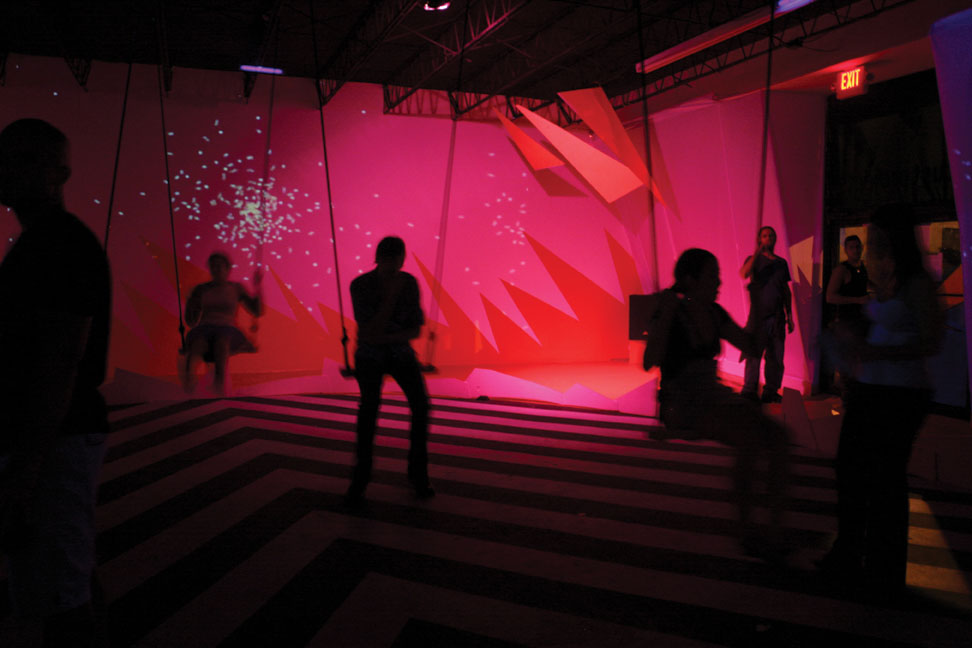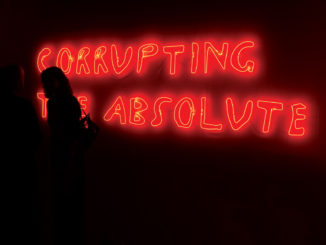
The TM Sisters combine a slew of seemingly unlikely elements in their work – art, specialized sports, club culture – and this friction is central to their most recent collaborative work at Locust Projects in Miami, Whirl Crash Go! The sister duo Monica and Natasha Lopez de Victoria are internationally recognized artists, and are also known in Miami – where they were born and raised – for their VJing events. They have been included in several noteworthy exhibitions and art publications including the Moscow Biennale, Art News, Art in America and Art Forum. They are the recipients of the 2009 Hilger Artist Project Award, which facilitated their dazzling and oh-so-Miami exhibition at Locust that opened the season this fall.
The project at Locust freed the TM Sisters from limitations that many other venues imposed – and it is certainly evident in the scope and ambition of Whirl Crash Go! Part performance, installation, video, and sound, the project infused with their usual knack for drawing a crowd, was more event than single piece. This was part of the goal; growing up in Miami meant attending a lot of shows and dancing in dimly lit, glamour-imbued environments, and this is something the sisters have chosen to embrace in their work. “Whirl Crash Go! charges the space in a different way,” says Monica, “(we) really love an experience, an overall feeling.” They also feel that the multi-sensory element is more impacting, more challenging, and more exciting. And it must be. Something the sisters did not anticipate was the line around the block at the gallery space opening night comprised of everyone from art aficionados and artists, to people looking for the hot and happening place to jam on a hot August night. The interesting part is, none of the folks in this spectrum would ultimately be let down.
The overall performance is like a 3D version of one of their videos, says Monica, but with the characters sharing the space with viewers. It’s a shift from video in that it involves physical connection with other people. Even the audience becomes part of the scene – whose setting is sort of a 1980’s MTV-meets-The Cremaster Cycle style night club – but with a modern, Miami edge (and minus everything phallic). Working in collaboration with designer Karelle Levy and audio composer Otto Von Schirach, the TM Sisters transformed the gallery space into a moving, bumpin’, electric atmosphere with just enough contemporary visual and conceptual intelligence to keep it art and not entirely a dance party. The line is very fine. This is what is remarkable about their work – they have found a way to use social scenes and Miami culture as their actual medium, and in doing so have incidentally opened up many different levels of access to the work; in part by widening their audience, and more thoroughly activating those from their generation, and raising the level of participation.
The lucky pre-capacity viewers opening night (the performance ran in shifts only opening and closing nights) were corralled into the center of the space, surrounded on all sides by an oblong path. Projection, neon tape, mirrors, and flashing lights engulf the senses from all sides. The girls, clad in their short, hip, fluorescent-accented gear and Aladdin Sane-esque war paint, unfold a loose epic-battle narrative that is multi-leveled in meaning. It is largely about the clashing of cultures in Miami – “it’s such a strange mixture,” Monica says, “sometimes sides disagree, but when it works it’s really beautiful.” It also touches on their joint efforts as artists. In the true ‘top that’ Teen Witch fashion, the girls instigate a silent face off of sorts – with their body language set to the beats of Von Schirach. Their force is split, and the elements representing Miami culture, and the sisters other interests as individuals, come into play in a rather unexpected manifestation.
Not only do sports in general seem to rarely collide with art, but the more obscure and dated practices of synchronized swimming and roller-skating – both of which require highly specialized skill and training – feel like two of the least likely and feasible possibilities for the interior of a gallery. Especially if we are talking about live performance. But, in a move as bold and brilliant as their aesthetic, they combined their respective passions for these sports with their joint passion for art and put them in the same arena. The hooded skaters, who side with Tasha, are jammin’, fluid, and with their loose, bass-driven movement represent the Caribbean and Hispanic cultures of Miami. Somewhat intimidating, they skate around and around the crowd in the ring left at the perimeter, stopping at times for skate break dancing interludes. In the sibling/artist battle facet of the story, they represent Tasha’s anger.
In contrast, the synchronized swimmers are rigid, austere, and have very angular movements set to a more euro-electronic beat. Amazingly, they constructed a sizeable pool in the gallery, where the swimmers, Monica’s cronies, perform their synchronized submerged acts beneath a grouping of fractured mirrors. The fragmented composition of abstracted arms and legs moving against the undulating surface of the water deepens the cold, severe image of the swimmers. It has a strange 60’s cinema quality in terms of aesthetic that sets them apart significantly from the more brazen, cool-kid skaters. The contrast is also self-referential: the sisters’ heritage is mixed much like that of Miami – they are part Puerto Rican, part German/Swedish. In fact, and coincidentally, the designer and composers’ backgrounds have similar compositions. The wardrobe, sound mixing, and dynamic of both sides are all the more effective and on-point for that reason. The nuances are subtle, yet very vital to the performance.
Other groups in the performance serve as sort of character/visual texture, with more historical/mythical asides. The “Booty Angels”, some pals of the girls with an incredible aptitude for the cry baby and all sorts of pelvic-centered booty movement, gyrate, gesture, and get down – placing an exaggerated emphasis on the rhythms created by the beat maker. Dressed in all white, they are exalted beings of the sky who are overseers of the conflict and operate at the whim of Von Shirach; who loosely depicts Thor, god of the heavens. When the conflict comes to a head near the end, and the skaters and swimmers engage in a literal and precarious tug-of-war where both sides are unable to get their grounding – the skaters, although on solid ground, experience a rare awkwardness on their wheels as they struggle to pull, and the swimmers flail in the water without the added balance of their arms – it is another group that materializes to symbolize the resolution.
A swarm of dancers, almost indistinguishable from the crowd, gathers with exuberance around the two remaining violent tuggers; which are of course the sisters. Their jovial dancing, which epitomizes Miami dance culture, and the early nineties, seems to lightly poke fun at both sides, and makes the lingering animosities forgotten, and the whole production essentially ends in a dance party – with the audience encouraged to join in.
Taken as a whole, the performance and decorated interior of the Locust Projects reveals some key aspects to the TM Sisters work. With all the visual elements working in conjunction with the simultaneous movement and action of the characters, the overall feeling is similar to Michel Gondry’s Daft Punk music video. All the senses are saturated and stimulated by an array of glowing elements, which resonate differently for different people. The sisters’ references to culture – pop, fashion, social and visual – whether intentional or not are indicative of their generation, and certainly their hometown. “It was kind of embarrassing, the eighties image of our city. Now people are finally okay with it, and are trying to embrace it,” says Monica, and it seems they have embraced their generation and how it fits in to their city’s history, and bent both to their will in a very effective way.
It is honest, playful, non-exclusive and can be experienced as highbrow, lowbrow, and everything in between without being tarnished by either affiliation. After all, who’d’ve thought synchronized swimming and booty dancing would occur not only simultaneously, but also in the realm of art? The combinations they weave – and the implications made by them – create a setting and a happening that allows the rest of the artworld to experience the place it is often only exposed to once a year. That is Monica and Natasha Lopez de Victoria – as individuals, as an art team, and moreover it is Miami; in all its mixed, young, neon, jam-pumpin’ glory.



Be the first to comment